Medium Tank Vickers Medium Tank Mk.I
In 1925, on the Vickers assembly lines, the tank Mk.I replaced the Medium Tank Mk.II created on its basis. The exact number of combat vehicles produced is unknown, but according to the available information, 168 Mk.I and Mk.II tanks were manufactured in the UK. Most of them were machines Medium Mark II. Thus, it can be concluded that the number of Medium Tank Mk.I tanks launched was several dozen units (probably, of the order of 50).
The inclination of the British military officials to the "diamond-shaped" tanks with tracks that completely covered the hull, firmly enough sat down in their minds, for a long time not giving rest. Such tanks continued to be developed in Great Britain even after the end of the First World War. An example is the family of TOG tanks, which ultimately put an end to stories similar tanks. Such combat vehicles attracted developers with high maneuverability and the ability to easily overcome the “lunar landscape” (the so-called battle fields of the First World War, tilled with funnels of shells and rows of trenches). But the minuses of the diamond-shaped tanks were much more. The sluggishness, large size, very low security of the tracks - all this made them easy targets on the battlefield, which German infantrymen and artillerymen have repeatedly been able to prove.
In 1919, the quite expected reorganization of the British tank forces took place, after which only 5 battalions remained in the Royal Tank Corps (KTK), which were equipped with Mk.B light tanks and medium Mk.V. The remaining tanks were sent to the reserve or made training machines. In the first post-war years in England, very small sums were allocated from the budget for the creation of new tanks, with most of the funding being spent on the Mk.D project that had not met expectations. The tests of this tank were completed in the 1921 year. Two years later, the Tank Design Department, which was responsible for the development of new tanks for the needs of the CPC, was completely closed. This finally stopped the flow of public money, which was aimed at creating new armored vehicles. But the development of the tanks did not end there, it was just being done proactively by British companies.
Back in 1920, the British infantry wanted to get a light tank, originally designated as the Mk.D, it had to have the Mk.V tank maneuverability and the Mk.A maneuverability. In 1921, Vickers-Armstrong (at that time one of the main suppliers of weapons for the British army) designed such a combat vehicle. The new tank received the designation Vickers Light Tank (sometimes it was also called Vickers Light Tank D). The combat vehicle retained the diamond shape of the hull, but received a spherical tower of circular rotation and, which was important, had a small size. Tests of Vickers Light Tank have been completed quite successfully. At least in terms of the main parameters, the new tank was superior to the Mk.C, but in 1922, all the forces of the company's specialists were thrown onto a more modern tank design, which received the designation Vickers Light Tank Mk.I. In 1924, the name was changed to Vickers Medium Tank Mk.I. At the enterprise, the tank was assigned the index A2E1.
The technical task, which was received from the military in 1922 year, provided for the development of a medium tank, the mass of which would be up to 12 tons. His main weapon was to be the 47-mm gun, and the reservation was supposed to be bulletproof. It was planned that in the very near future the tank would completely replace the obsolete Medium Mk.C, becoming the main Royal Tank Corps.
The hull of the Medium Tank Mk.I tank had a metal frame that was trimmed with armor plates of the same thickness using the riveting method. The thickness of the rolled armor plates was only 6,35 mm (a quarter of an inch). At the same time, the box-shaped case with vertical side and rear walls did not contribute to better protection. Such a reservation could save the crew, units and aggregates of the tank only from a light rifle. weapons and would not survive under shelling by armored bullets and enemy artillery fire. For example, a circular reservation tank Renault FT was 16 mm, which provided reliable protection against any bullets rifle caliber.
In the front of the tank hull on the right side there was a control compartment with a driver's seat, a special cylindrical-shaped armored cap was located above the driver's seat. On the left side of the mechvod was located the engine compartment (MTO). For the driver was a fighting compartment with a tower of circular rotation. The tank tower had a cylindrical shape with roof bevels on the sides. To observe the terrain, the crew of the tank had to use the inspection slits.
The crew of the combat vehicle consisted of 5 people: driver, commander, loader and two machine gunners. The commander of the tank also had a periscope panoramic sight. Landing and disembarking from the tank of the crew members was carried out from two hatches along the sides of the combat vehicle and the aft door, which was the door in the literal sense of the word. There was also a large double hatch in the roof of the tower, the driver had his own hatch. The height of the tank exceeded the 2,8 meter. This was caused by the front arrangement of the engine compartment. At the same time, the high height of the hull made the crew more comfortable.
The chassis of the tank remained multi-wheeled, like the previous developments of the Vickers company. It consisted of 10 support and 2 "independent" rollers, as well as 4 supporting rollers, front guide and rear drive wheels on each bead.
The tank tower became the product of the further evolution of the tower of the previously presented tank Vickers Infantry Tank No.1. The tower also skated chase on 3's large rollers, which were installed from the outside. At the same time, the company's engineers abandoned the complex spherical shape, making the tower more similar to the one installed on Rolls-Royce armored cars. The 3-pound Vickers cannon (47-mm) with caliber barrels 50 and immediately Hotchkiss 4 machine gun (3 around the perimeter of the turret and another anti-aircraft gun) were placed in the turret. Considering the fact that the entire 2 crew member was in the turret, such a number of machine guns looks at least strange. But even more strange is the fact that 2 machine guns were placed on the sides of the hull, this time produced by Vickers. For what purposes it took on the tank to put the machine guns of two different companies, is a mystery.
It is also interesting that in the ammunition of the British 47-mm gun there were no high-explosive fragmentation shells. Medium Tank Mk.I was the first tank in which the British military implemented their concept of “enough machine guns for infantry”. The concept, as practice has shown, was very controversial. British tankers checked it out on their own skin during World War II. However, high-explosive fragmentation ammunition was part of the 3,7-inch (94-mm) tank howitzer ammunition, which was armed with some tanks, designated Medium Mark I CS (direct fire support tanks). In the ammunition of these combat vehicles were smoke shells.
The power plant of the tank was represented by the 8-cylinder carburetor air-cooled engine Armstrong-Siddley, which developed the power of the 90 hp. The engine was located to the left of the driver. The transmission of the tank included an 4-speed gearbox and multi-plate clutch without synchronizers. While the combat vehicle was moving, the crash of shifting gears was added to the noise of the Armstrong-Siddley engine. In sum, uninitiated people could get the impression that the transmission of the tank was about to collapse completely.
The fuel system did not differ much novelty. The fuel reserve was located in two fuel tanks, which were located in front of the hull on top. From them the fuel entered the intermediate tank, from where it was already moving by gravity to the engine. For cooling and lubrication of the power plant was created 4-gallon tank, which houses the entire stock of oils. However, it soon became clear that the current consumption, as well as oil leakage during the operation of the tank is very high, so the serial combat vehicles received 13,5-gallon tanks for oil. In the opinion of British Major General N. V. Duncan, who took part in accepting Medium Tank Mk.I tanks and monitoring their operation in the army, such technical decisions were a step backwards, which left the country’s tank design at the level of the First World War.
On tests of the tank, which were carried out in 1923-1924 years, he showed comparable performance with the Mk.V tank, while possessing slightly better maneuverability. The maximum speed of the tank during the tests was 24 km / h (15 miles / h), and the cruising range was about 190 km (120 miles). After completing a series of tests, the medium tank was considered suitable for launching into mass production. At the same time in 1924, the combat vehicle was put into service with the KTK, and its serial production began at the Vickers facilities.
Almost immediately, work began to improve and create new modifications. Improved modification of the tank received the designation Mk.IA. First of all, the tank reinforced the reservation, the thickness of the vertically placed armor plates was brought to 8 mm. To facilitate firing at air targets, the rear part of the turret received a small bevel, and on-board machine gun installations were also improved. The tank engine could now be started not only from the inside, but also from outside the combat vehicle (before that, it was possible to start only from the control unit). Tanks of this series began to produce with the 1925 year.
Started active military operation of the new armored vehicles revealed numerous technical flaws, primarily related to the running tank. During the marches, the track rollers were often broken down, so the crews of the Mk.I tanks had to stock up for the future, and the entire path from the army training grounds to the locations of the tank units was littered with discarded rollers. At the same time carrying out repair of the undercarriage in the field conditions turned out to be very difficult, therefore, armored vehicles were very often dismantled from the combat vehicles, which covered the external suspension elements and transmissions. In the future, on all the released Mk.I and Mk.IA tanks, the installation of new road wheels, featuring an improved design, was carried out.
Soon enough, another modification appeared, which received the designation Mk.IA *: on these tanks, the Hotchkiss turret machine guns were replaced with the Vickers machine gun coupled to an 7,7-mm machine gun. The empty ball installations were simply covered by armor plates. In order to improve the view of the surroundings, a small commander dome (Bishops's Miter) was placed on the roof of the tower. In the army, he was nicknamed the "episcopal miter."
A very limited series of tanks were released fire support, designated Mk.ICS. Instead of the 47-mm cannon, a short-barreled 15-pound (94-mm) tank howitzer was mounted on these combat vehicles, and the high-explosive and smoke projectiles were in ammunition for this tank.
But of all the modifications, the most interesting is the wheel-tracked variant, which received the designation Vickers Wheel-Cum-Track Tank. This combat vehicle was introduced in 1926 year. The main goal of the developers was to study the possibility of increasing the speed of the tank, at the same time solving the problem of wear of the tracked undercarriage combat vehicle. The transition from caterpillar to wheel travel was carried out with the help of mechanical jacks with power take-off from the engine, it took only one minute. The first copy of the wheel-tracked Vickers Wheel-Cum-Track Tank Mk.I was able to pass the test with varying success - the control of the fighting vehicle during the wheel course turned out to be very difficult, while the maximum speed almost did not increase. Both of the problems that arose during the trials tried to be solved in the modification of the Vickers Wheel-Cum-Track Tank Mk.Ia, which differed only in the presence of rear wheels of increased diameter. But after a fairly lengthy test, the final conclusion was made that this direction of development of the tank was unpromising and at the beginning of 1928 the work on the wheeled-tracked tank was finally stopped.
The career of Medium Mk.I tanks in the British Army was quite long. Although already in the 1926 year, they were gradually replaced with newer Medium Tank Mk.II, the last Mk.I tanks were finally decommissioned only by the 1938 year. They were actively used during the exercises of the interwar period and became a real “learning desk” for many British tankers of those years. At the same time, several tanks were also sent to the colonial possessions of Great Britain, but the exact number of "export» Medium Tank Mk.I is very difficult to call. Oddly enough, it was precisely such an export past that gave the tank a future, allowing it to keep the rare combat vehicle to this day. The only retained medium tank Vickers Medium Tank Mk.I is now on display at the Special Services Batallion Museum, located in the city of Blomfonteyn in South Africa.
Technical characteristics of Vickers Medium Tank Mk.I:
Overall dimensions: length - 5330 mm, width - 2780 mm, height - 2820 mm.
Combat weight - 11,7 t.
Reservations - 6,35 mm (round trip reservation).
The power plant - 8-cylinder carburetor air-cooled engine Armstrong Siddeley, hp 90 power.
Speed - 24 km / h (on the highway).
Power reserve - 190 km.
Armament - 47-mm gun QF 3 pounder Vickers, 4x7,7-mm Hotchkiss M1909 machine gun and 2-X7,7-mm Vickers machine gun
Crew - 5 man.
Information sources:
https://www.aviarmor.net/tww2/tanks/gb/medium_mk.1.htm
http://warspot.ru/5605-medium-tank-mk-i-pervyy-manyovrennyy
http://armoredgun.org/brm003/brit_12_vickers_mk1.html
Open source materials
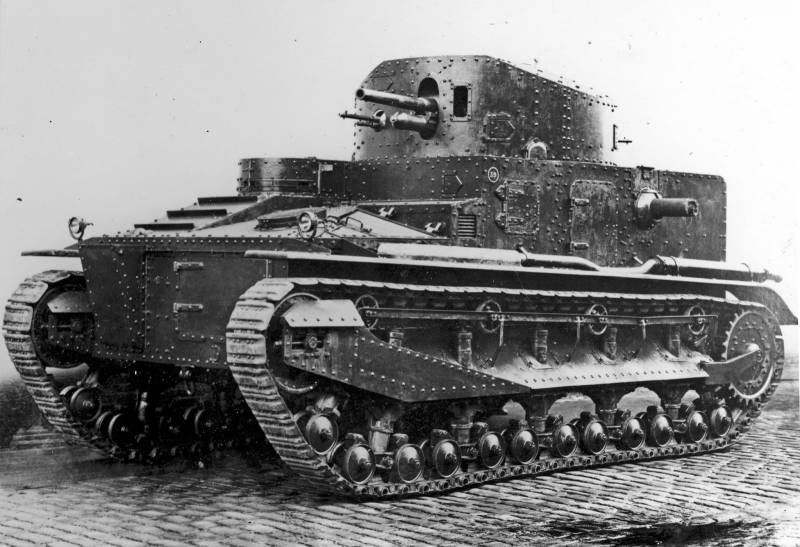
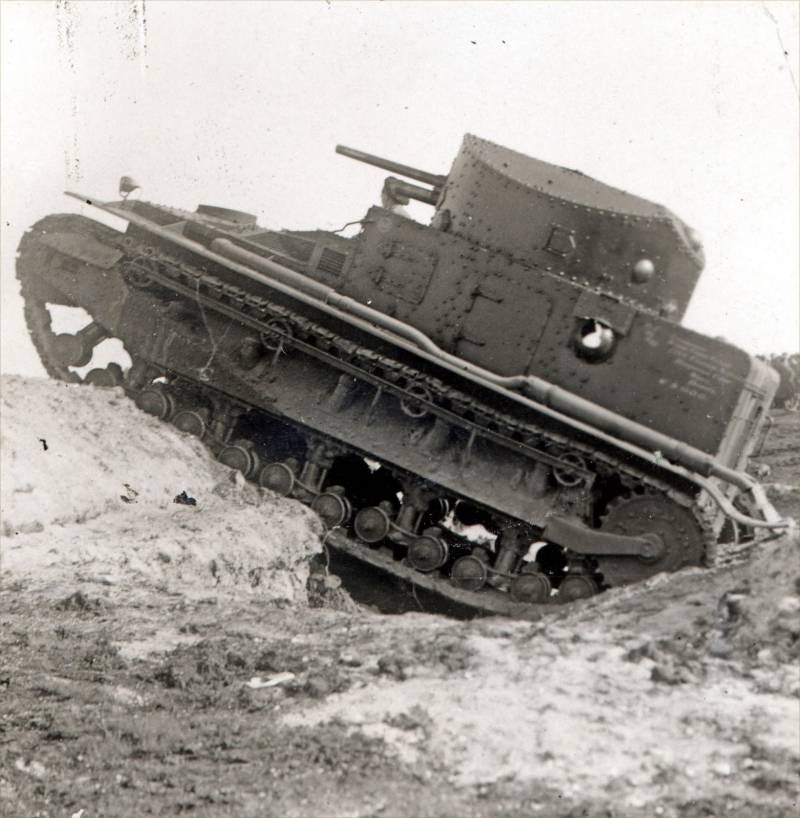
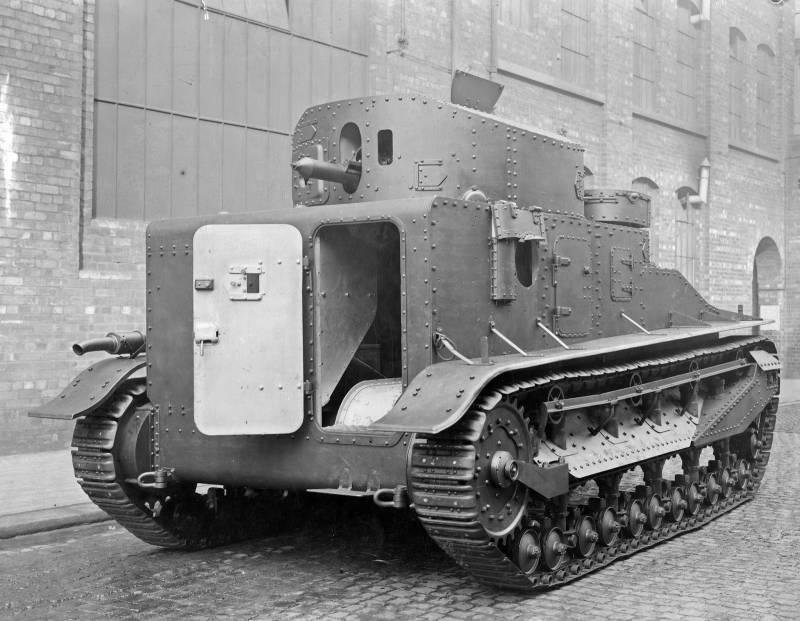
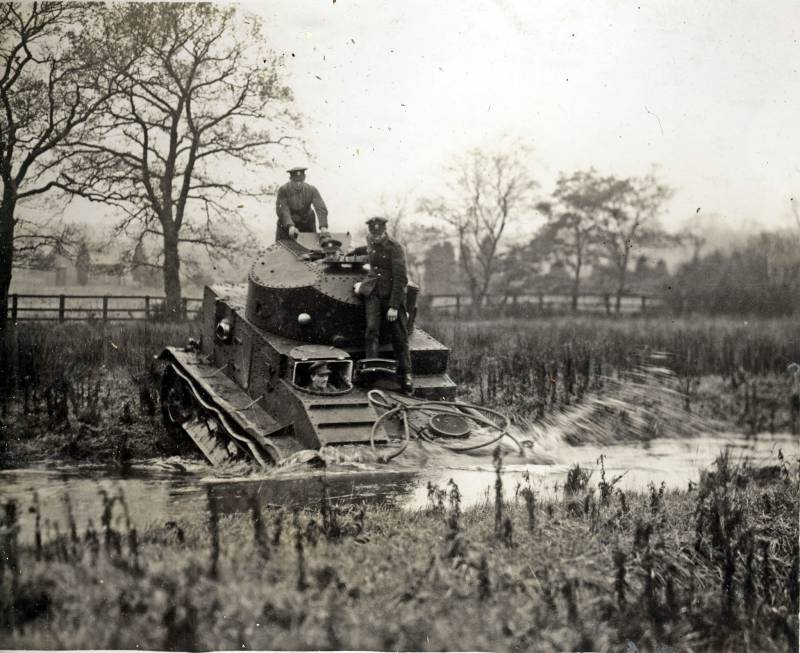
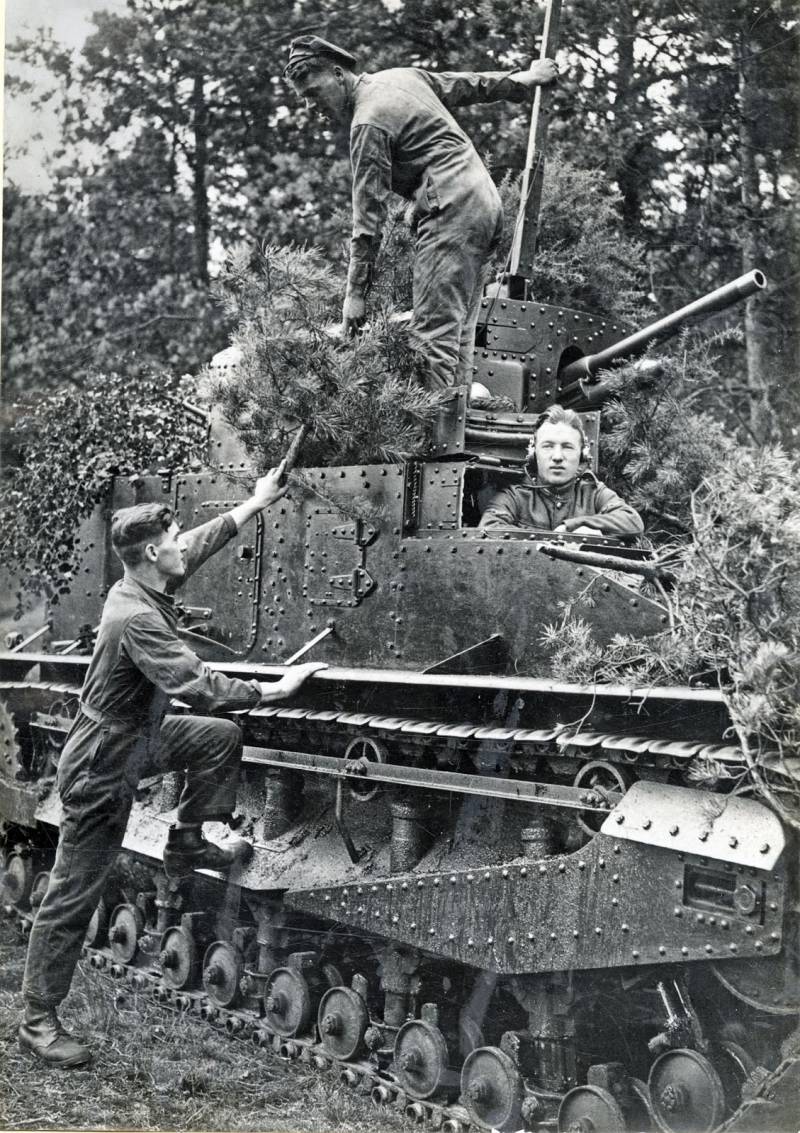
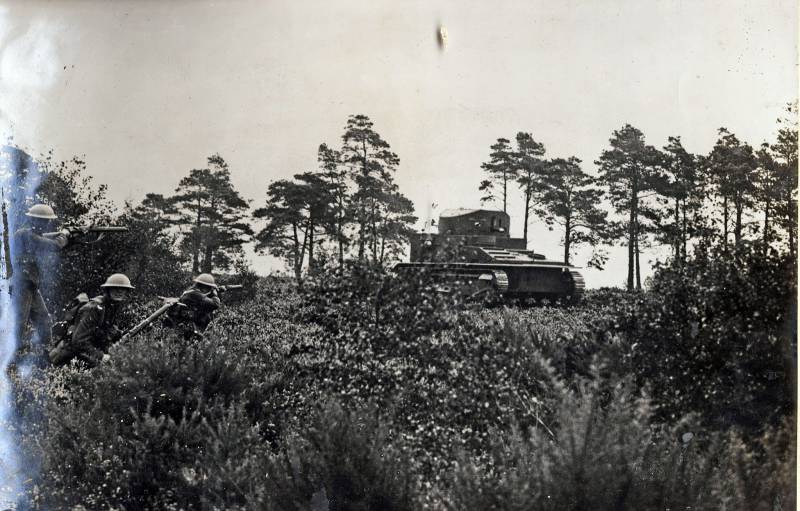
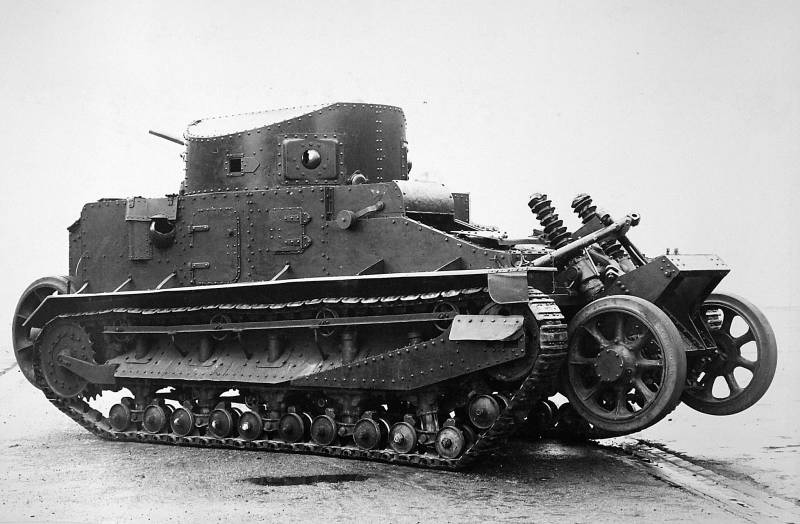
Information